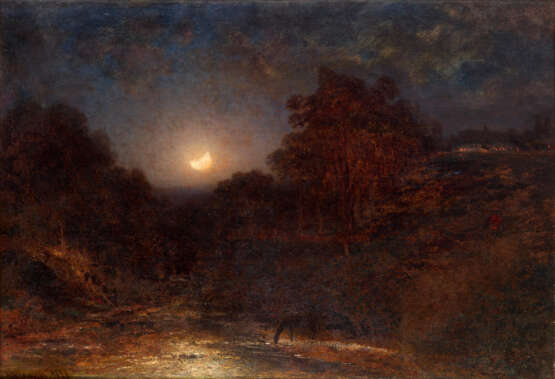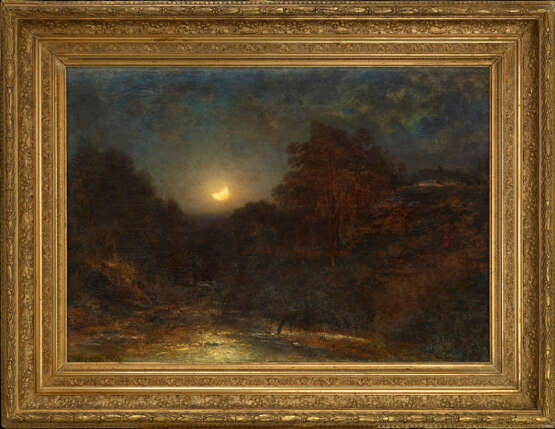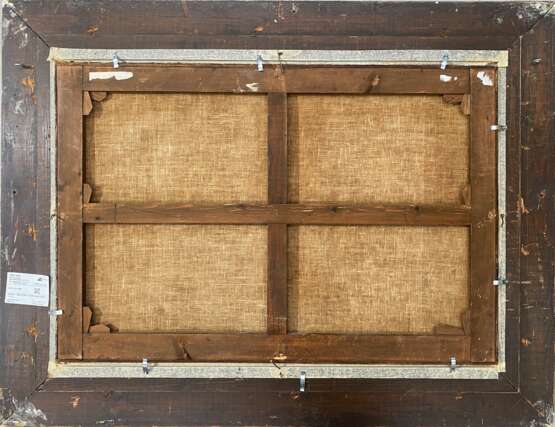ID 1103644
Lot 15 | BOGOLIUBOV, ALEXEI (1824-1896)
Estimate value
£ 150 000 – 200 000
Oil on canvas, 70.5 by 104.5 cm.
Provenance: Private collection, UK.
Authenticity certificate from Vladimir Petrov.
Moonlit Night was executed by Bogoliubov in the province of Saratov in the summer of 1883. That year, the artist’s visit to the region in which he had spent his childhood years was connected with a special event: in May in Saratov’s Teatralnaya Square the foundations were laid for the building containing the future Museum of Art, to the preparations for which Bogoliubov had devoted many years. This was to be the first museum in Russia to be open to general public, and the artist had conceived the project in memory of his grandfather, who had been a publicist and intellectual during the reign of Catherine the Great, and the museum was given his name, Radishchev.
After the grand ceremonies, to quote Bogoliubov himself, there was nothing for him to do in the city and he and his brother set off into the depths of the province to Kuznetskiy district, where Radishcheva, an aunt of the artist, lived in her own estate. In Bogoliubov’s diary we have a description of this area: “The large garden was somewhat neglected. The apple trees were laden with fruit, and there were abundant clusters of raspberries, and of wild and cultivated strawberries. All kinds of birds, pigs, sheep and turkey hens were running around the yard and escaping into the hemp field, and sometimes even into the threshing machine – an antediluvian contraption which was operated by 10 horses...”
From the artist’s home region he brought a large number of Volga land scapes to St Petersburg, and these probably included Moonlit Night. This work, like the recognised masterpieces by Bogoliubov – Moonlit Landscape. The Grand Canal in Venice (The V. Tropinin Museum), Moonlit Seascape (The State Russian Museum), and Summer Night on the Neva (The State Tretyakov Gallery) – was devoted to one of the artist’s favourite themes, the portrayal of night time light effects.
However, this time Bogoliubov depicted a typical middle Russian landscape: gently flowing waters between the low banks of the river, bathed in flickering golden moonlight; the soft lines of the river banks and the diffuse subdued lighting, illuminating only the nearest part of a landscape which has been plunged into darkness; homes with twinkling lights in a little village visible in the distance, trees growing along the sloping banks of the river and a horse who has come down to the watering hole.
In his quest for a means of conveying quivering air and iridescence of moonlit water, Bogoliubov resorted to a method that utilised the expressive potential of brushwork and texture. Moonlit Night is filled with elusory light shimmering on the mirror-like surface of the river. There is a particular sense of movement in the landscape. This impression is conveyed to the viewer by the uneven, broken brushstrokes that reflect the vibrations of the gentle waves and the vibration of nocturnal air, illuminated by the golden light of the moon.
Bogoliubov’s painting methods are close to those of the Impressionists, and his subdued combinations of brown, ochre, and dark green tones not only convey the variety of shades of the earth, water, and sky, but also play an important role in the colour modelling of the various subjects of the artist’s work. Moonlit Night was to prove a landmark on the path of development of Russian plein air painting and the creation of an emotional land scape, which was in Bogoliubov’s creative oeuvre invariably coloured by an awareness of the harmony between nature and human beings content with their own existence on earth.
| Artist: | Alexey Petrovich Bogolyubov (1824 - 1896) |
|---|---|
| Auction house category: | Paintings & Sculptures 19th & 20th Century |
| Artist: | Alexey Petrovich Bogolyubov (1824 - 1896) |
|---|---|
| Auction house category: | Paintings & Sculptures 19th & 20th Century |
| Address of auction |
MacDougall Arts Ltd. 33 St James’s Square SW1Y 4JS London United Kingdom | ||||||||||||||
|---|---|---|---|---|---|---|---|---|---|---|---|---|---|---|---|
| Preview |
| ||||||||||||||
| Phone | +44 20 7389 8160 | ||||||||||||||
| Phone | +7 495 799 4683 | ||||||||||||||
| Fax | +44 (0) 20 7389 8170 | ||||||||||||||
| Buyer Premium | 27 % | ||||||||||||||
| Conditions of purchase | Conditions of purchase | ||||||||||||||
| Business hours | Business hours
|






